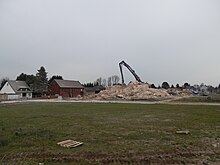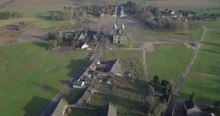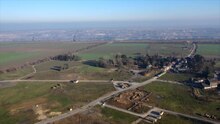Immerath (Erkelenz)
|
Immerath
City of Erkelenz
Coordinates: 51 ° 3 ′ 4 " N , 6 ° 26 ′ 16" E
|
|
|---|---|
| Height : | 92 (78-115) m |
| Area : | 9.34 km² |
| Residents : | 23 (Jun 30, 2020) |
| Population density : | 2 inhabitants / km² |
| Incorporation : | January 1, 1972 |
| Postal code : | 41812 |
| Primaries : | 02431, 02164 |
|
Location of Immerath in the mining area of the Garzweiler opencast mine
|
|

Show as spherical panorama

Show as spherical panorama
Immerath was a rural place and since 1972 a district of Erkelenz in the district of Heinsberg in North Rhine-Westphalia . The village was located in the mining area of the planned Garzweiler open-cast lignite mine of RWE Power and has therefore been relocated since 2006. In 2018, when the church was demolished, only a few houses were still inhabited. The district of Immerath included the hamlet of Lützerath , which also had to give way to open-cast lignite mining and was being relocated, as well as the old village of Pesch , where lignite was already being mined. The newly emerging place is called Immerath (new) . Immerath is now being excavated piece by piece by Garzweiler's bucket wheel excavators.
geography
Immerath lay in the fertile Erkelenz Börde on the main terrace.
In the south the landscape rose to the Jackerath Lössschwelle to 115 m, in the north it drops to 78 m towards the Niers lowland .
location
Immerath bordered in the north on Alt- Borschemich , in the northeast on Alt-Spenrath and Alt-Otzenrath , in the east on Alt-Garzweiler , in the south on Jackerath and in the west on Holzweiler .
geology
Sands and gravels as well as several brown coal seams from the Tertiary are found underground . The surface is covered with loess .
history

Place name
The village was first mentioned in 1144 as Emundrode . In 1530 the place name was Emenrait and in 1666 Emeradt . From the end of the 17th century it was called Immerath.
The name is made up of the personal name Aiwismund ( aiwi - in Middle High German ewe - means law, the Old High German munt guardian) and the basic word reod . The place was therefore a clearing of the Aiwismund or Edmund . Settlements from the clearing period were founded in the Erkelenzer Land mainly in the 9th to 11th centuries.
Various religious institutions owned farms in Immerath: In 1144 the provost of Millen is mentioned. 1349 reached a farm as a donation to the monastery of the Benedictine nuns in Nonnenwerth . The Abbey of the Cistercians in Altenberg acquired a property from the 1426th
A knight family named themselves in the High Middle Ages after the place, whose castle was north of the church. A Heinrich von Emenroide had three cross bars in his seal shield. This family died out around 1400. The castle complex later fell into disrepair.
In the Middle Ages and in the early modern period , Immerath was in the Dingstuhl (judicial district) Holzweiler, which was part of the Kaster office in the Duchy of Jülich .
From 1794 to 1814 Immerath belonged to France and formed a mairie (mayor's office). In 1804 the independent Mairie Holzweiler was added to Mairie Immerath, which now consisted of the towns of Holzweiler, Immerath, Lützerath, Pesch and Spenrath and the Eggerath, Roitz and Weyer farms. The community was in the canton of Erkelenz.
In 1815 Immerath became part of Prussia and in 1816 became mayor of the district of Erkelenz . The village of Spenrath was spun off from the mayor's office and became part of the Neukirch mayor's office, later Hochneukirch (Grevenbroich district).
The mayor's office was dissolved in 1935, Immerath became a special municipality and was combined with the office of Holzweiler.
On February 27, 1945, American soldiers from the 116th Regiment of the 29th Infantry Division took the village during Operation Grenade .
On January 1, 1972, the office was revoked, Immerath now came to the city of Erkelenz.
Relocation
Neu-Immerath has been built since 2006 and relocation started. The demolition of the old village began in 2013 and lasted until mid-2018. After the closure of the section of the federal motorway 61 between the Jackerath triangle and the Mönchengladbach-Wanlo triangle , Immerath can be excavated by the opencast mine, probably from 2018.
Monastery House Nazareth
The Congregation of the Daughters of the Holy Cross from Liège had been running an educational institution for epileptics in Düsseldorf-Rath since 1881, but it was soon overcrowded, so that in 1901 they founded a new branch in Immerath. In 1902 and 1903 the monastery, chapel and hospital wing were built and by 1904 the institution accommodated 95 patients who were cared for by 16 sisters. In 1921 it became an educational institution for welfare pupils who were no longer of school age and in 1926 was named Haus Nazareth .
The patients of the Nazareth House were also exposed to the National Socialist ideology of " destroying life unworthy of life ". Between 1941 and 1944, 125 of them fell victim to the murder wave, which was kept secret and later became known as Aktion T4 . The public was fooled into believing that patients were being transferred because hospitals were needed due to the war.
Towards the end of the Second World War , "Haus Nazareth" served as a hospital . When the hospital in Erkelenz was destroyed after the war, it became a temporary district hospital. In 1962 a new hospital was built, which initially entered into a cooperation with the Erkelenz hospital in 1976 and became its sponsor in 1988. The monastery itself then served as a retirement home for sisters of the congregation and was dissolved in 2001. The hospital with its specialist departments moved to the expanded Hermann Josef Hospital in Erkelenz in 2009 . The demolition took place in 2015.
religion
The majority of the population was Catholic. The parish Immerath was first mentioned in 1288, its patron was St. Lambertus . On January 1st, 2010 the parish was merged with ten other parishes to form the parish of St. Maria and Elisabeth Erkelenz .
The Catholic cemetery was rebuilt in Neu-Immerath and the dead were reburied.
The places Immerath, Pesch and Lützerath belonged to the Protestant parish of Otzenrath-Hochneukirch.
Jews have also lived in Immerath since 1774, although more precise dates are only documented for the 19th century. In 1876, for example, there were ten Jewish residents in Immerath and five in Pesch.
Population development
The population of Immerath increased significantly at the end of the 19th century. Since the beginning of the 21st century, however, they have been continuously decreasing due to the expansion of open-cast lignite mines:
| year | 1767 | 1799 | 1818 | 1849 | 1871 | 1895 | 1925 | 1939 | 1961 | 1970 | 2008 | 2009 | 2010 | 2013 | 2017 |
| Ew | 399 | 495 | 733 | 798 | 1172 | 1049 | 1307 | 1309 | 1496 | 1537 | 712 | 557 | 401 | 40 | 13 |
Facilities
- The Hermann Josef Hospital II ("Nazareth House") with 110 beds was relocated to Erkelenz in 2008.
- Event room Kaisersaal (use will be discontinued in September 2014 at the latest)
- Municipal kindergarten (use will be discontinued in September 2014 at the latest)
traffic
Rail transport
On October 1, 1873, the Bergisch-Märkische Eisenbahn-Gesellschaft opened the Mönchengladbach – Hochneukirch – Jülich line with connections in the direction of Jülich and Hochneukirch . The route was nationalized in 1882. Immerath was only given a train station at the mill and the local border with Jackerath in 1909. On June 1, 1980, the line was shut down and dismantled by the Federal Railroad against all protests. The station then lost its function and was then privately owned. The nearest possible rail connection for the residents was Hochneukirch, approx. 7 kilometers from Immerath.
Public transport
Until December 9, 2017, Immerath was served by bus route EK 3 (Erkelenz – Keyenberg).
Road traffic
The A 61 ran east of Immerath. In Jackerath a junction of the same name was located on the A61 with access to the A 44. In July 2018, the dismantling of the A61 began between junctions Wanlo and Jackerath as these in the plan mining area for the Garzweiler is, as a substitute applies for the A 44 or A44 new.
Attractions
Parish Church of St. Lambertus
The church building was built from 1888 to 1891 according to plans by the Cologne builder Erasmus Schüller. A neo-Romanesque basilica with a double tower was built. Due to its enormous size, the building was also known as the "Cathedral of Immerath". Above the main portal there was a tympanum with Christ as the enthroned ruler of the world ( Pantocrator ). The church windows were made by the Cologne glass painting workshop Schneiders & Schmolz . Anton Wolff designed the rose window .
123 years after its inauguration, the church was de-dedicated with a funeral service on October 13, 2013, as it stood in the way of the expansion of the Garzweiler II open-cast lignite mine . The church building was handed over to RWE Power in April 2014 and was demolished within two days from January 8, 2018. The demolition was accompanied by protests and nationwide media coverage. Shortly before, a private initiative managed to save some church windows. A stone figure of Christ was also recovered and is to be put up again in Bonn behind the Franziskuskirche .
On January 1st 2010 the parish of St. Lambertus merged with ten other parishes to form the parish of St. Maria and Elisabeth, Erkelenz. According to the will of the diocese of Aachen, a new church should no longer be built at the resettlement site despite the wishes of the population. A chapel was built at the new location . 4 of the 6 church bells from the 15th and 17th centuries have also moved.
Immerather windmill
The Immerather mill was under monument protection standing tower windmill or a mountain Dutchman . Until it was demolished in October 2018, the mill was clearly visible between Immerath and Jackerath on the border of the Erkelenz city area.
More Attractions
- The hail cross from 1686
- The seven footfalls of 1784
Movie
In 2014 the film “ We are the flood ” was shot in Immerath . The largely abandoned village of Immerath served as the backdrop for the fictional place Windholm on the North Sea.
Culture
Regular events
- Shooting festival and late fair
- Carnival events (session opening, gala session, BSE ball / prince bivouac, costume ball, Rose Monday procession and ball)
- Our village plays football
- Dance into May
societies
- Carnival Society Seckschürger from 2001 e. V.
- St. Sebastianus Shooting Brotherhood Immerath from 1555
- Sports club Immerath from 1911 e. V.
Personalities
- Johann Corsten (1891–1982): Amtsrentmeister , brother master 1954–1972, holder of the Federal Cross of Merit and honorary citizen of the city of Erkelenz
- Eva Kreissl (* 1958), cultural scientist, folklorist and curator
- Ralf Georg Czapla (born June 24, 1964 in Immerath), literary and cultural scientist
- Gisela Berger: As chairwoman of the Citizens' Council, largely responsible for the design and reconstruction of the infrastructure at the new location; awarded the badge of honor of the city of Erkelenz
literature
- Karl L. Mackes: Erkelenzer Börde and Niersquellgebiet. Series of publications by the city of Erkelenz No. 6, Mönchengladbach 1985.
- Franz-Karl Bohnen: Farewell to the Immerather monastery . In: Local calendar of the Heinsberg district . Heinsberg 2002, p. 135 ff .
- Thomas Milika: Can the Immerather Mühle still be saved? In: Molina. Mills and people. 6-2018. P. 58f.
Web links
- Website of the city of Erkelenz
- Documentation Garzweiler - Immerath
- Photo album and information about Immerath | September 2015
- Diary of the initiative "Creative against Coal" with information about a possible preservation of the Immerather windmill
Individual evidence
- ↑ Update of the population on June 30, 2020 (PDF). In: Website of the city of Erkelenz. Retrieved July 15, 2020 .
- ^ Federal Statistical Office (ed.): Historical municipality directory for the Federal Republic of Germany. Name, border and key number changes in municipalities, counties and administrative districts from May 27, 1970 to December 31, 1982 . W. Kohlhammer, Stuttgart / Mainz 1983, ISBN 3-17-003263-1 , p. 307 .
- ↑ Harry Seipolt: "... comes from an antisocial and hereditary clan". Forced sterilization and Nazi euthanasia in the Heinsberg district 1933–1945. In: Heimatkalender des Kreises Heinsberg , year 1992, pp. 112–124. The relevant documents can be found in the public prosecutor's investigation files 8 Kls 8/48 of the Düsseldorf jury court of November 24, 1948 (euthanasia in the Rhine province) together with the appeal judgment of July 23, 1949.
- ^ Karl L. Mackes: Erkelenzer Börde and Niersquellgebiet. Mönchengladbach 1985, p. 430.
- ^ Population numbers according to Karl L. Mackes: Erkelenzer Börde and Niersquellgebiet. Mönchengladbach 1985, p. 126.
- ↑ Newspaper of the Association of German Railway Administrations, Volume 49, No. 39, p. 642.
- ↑ a b Nikolaus Bernau : Mr. Pütz wants to stay. In: Berliner Zeitung , July 25, 2013.
- ↑ Benedikt Erenz: This cathedral is being torn down. In: Die Zeit , July 25, 2013.
- ^ Moving farewell in Immerath Cathedral. On RP-Online October 13, 2013, accessed December 14, 2016.
- ↑ Jörg Diehl: Farewell in Immerath: A cathedral closes. Spiegel Online from October 13, 2013, accessed on December 14, 2016.
- ↑ Articles on demolition and the church in general
- ^ Research Center for Glass Painting of the 20th Century eV
- ↑ [1]
- ↑ Rheinische Post from January 4, 2014









